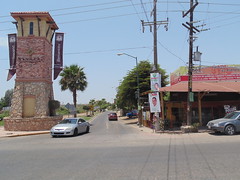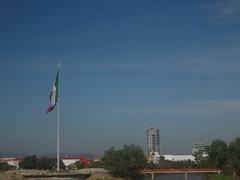Culiacán
Culiacán, officially Culiacán Rosales, is a city in northwestern Mexico, the capital and largest city of both Culiacán Municipality and the state of Sinaloa. The city was founded on 29 September 1531 by the Spanish conquerors Lázaro de Cebreros and Nuño Beltrán de Guzmán under the name "Villa de San Miguel", referring to its patron saint, Michael the Archangel.
As of the 2020 INEGI census, Culiacán had an estimated population of 808,416, placing it as the 21st most populous city in Mexico, while its metropolitan area had a population of 1,003,530, being the 17th most populous metropolitan area in Mexico.
The city is in a valley on the slopes of the Sierra Madre Occidental, at the confluence of the Tamazula and Humaya Rivers, where both join to form the Culiacán River 55 m above sea level.
Etymology
The genuine Aztec name of the Nahuatl language is Colhuacán or Culhuacán, which is from colhua or culhua and can, which is a place, and its meaning varies according to different historians:
- "snake place"
- "crooked hill"
- "where walkers twist the path"
The most respected theory is "place of the colhuas", that is "inhabited by the colhua tribe", and the most frequent meaning is "place of worshiping the god Coltzin".
History
Prehispanic era
In ancient times, there was an indigenous settlement called Huey Colhuacan that dated back to Tecpatl, which corresponds to the year 628 CE. The Aztecs built it during their pilgrimage. Its exact location is unknown, but it is assumed that it was close to the current town of Culiacáncito. The ancient settlers were called Culichis.
Founding
The city that we know today as Culiacán was co-founded in 1531 by conquistadors Lázaro de Cebreros and Nuño Beltrán de Guzmán under the name "Villa de San Miguel". Upon their arrival in the 16th century, the Spanish found the existence of farmhouses organized in indigenous nations by the tribe of the Tahues, which brought together a group of people of the same origin and language who had a common tradition.
Other indigenous peoples that inhabited the original territory of Culiacán were the Tebacas, Pacaxes, Sabaibo and Achires.
After their war of conquest, in 1531, de Cebreros and de Guzmán organized the territories acquired into three provinces. One of them was Culiacán, which was delimited to the South by the Elota River and to the North by the Mocorito River, depending on the Kingdom of Nueva Galicia. Organized in this way, the territory lasted until 1786, the year in which the administration system was implemented, with Sonora and Sinaloa forming the province of Arizpe and the older province of Culiacán remaining the same.
Independent Mexico
On 6 October 1821, independence was sworn in Culiacán. Culiacán was granted the category of city, on 21 July 1823, when the provinces of Sonora and Sinaloa separated by decree from Congress. In 1824, by the Constitutive Act of the Mexican Federation, Sinaloa and Sonora met again, forming the state of the West. On 13 October 1830, the provinces of Sonora and Sinaloa were definitively separated by decree, with the city of Culiacán designated capital of the state of Sinaloa. In 1861, during the conservative government of the French Intervention, prefectures were installed and the Municipalities Law was decreed that divided the Districts into City Councils. The Badiraguato District was suppressed and became part of the Culiacán District as a municipality.
From 1859 to 1873, the capital of Sinaloa was moved from Culiacán to Mazatlán. In the Restored Republic, Governor Eustaquio Buelna confronted the merchants of the port. He returned to Culiacán and the Local Congress gave it the status of capital of the state.
Porfirian and revolutionary times
In 1878, Culiacán had three City Halls, whose headwaters were Culiacán, Quilá and Badiraguato. It remained that way until 1880, when Badiraguato returned to being a district with the limits that previously corresponded to it.
The year 1912 was when municipalities were established by law as a new form of internal government, but it was not until 1915 that this law came into force and political directories were suppressed, causing the districts to become free municipalities.
Culiacán was established as a municipality by decree on 8 April 1915. Within its original limits was the current Municipality of Navolato, which was segregated from Culiacán on 27 August 1982, depriving the city of of valley agriculture.
Sometime later, the State Congress approved the extension of the name of the capital city, giving it its current official name of Culiacán de Rosales. "Rosales" honors the great Mexican military man Antonio Rosales, who fought in the second French Intervention and the Reform War, along with serving as the governor of Sinaloa.
After World War II
Beginning in the late 1950s, Culiacán became the birthplace of an incipient underground economy based on illicit drugs exported to the United States. The completion of the Pan-American Highway and the regional airport in the 1960s accelerated the expansion of workable distribution infrastructure for the enterprising few families that would later come to dominate the international drug cartels along Mexico's Pacific Northwest. The Sinaloa Cartel made Culiacán its primary base.
On 17 October 2019, after an ultimately unsuccessful attempt to arrest one of the cartel leaders, widespread gunfights broke out across the city, leading to multiple deaths, in what has been called the "Battle of Culiacán". One of Joaquín "El Chapo" Guzmán's relatives, Ovidio Guzmán, was arrested by police, but were forced to release him.
Coat of arms
The coat of arms of the municipality and the city of Culiacán in Sinaloa, Mexico, has various elements that represent the history of the municipality yesterday and today.
Rolando Arjona Amábilis was the artist behind the official coat of arms of the Municipality of Culiacán, which was made official through municipal decree number 13 May 26, 1960 and published in number 90 of the Official Newspaper of the State of Sinaloa on 30 July 1960.
Its shape is square with rounded corners, ending in a point. The entire face of the shield is covered with a carmine color. In the center is a hieroglyph representing a hill with a human head inclined forward. This glyph alludes to Coltzin, "the crooked god", an authentic figure of Nahuatl mythology, who gave its name to the Nahuatlaca-Colhua tribe and, in turn, to the town of its residence, Colhuacán or Teocolhuacán.
Across the face of the shield, there are symbols of water referring to rivers. In the central part and towards the left side, a cross is followed by a path on which footprints can be observed that end in a small construction. These motifs symbolize the missionaries of San Miguel de Culiacán left for the North, and they are invoked as an obligatory tribute to the goodness and heroism of the missionaries.
On the carmine border, the word "Culiacán" can be read in its upper part, and in its lower part the word "Colhuacán", which corresponds to the true name of the place in the Nahuatl language. In the upper part of the shield, there is a hill with a germinating seed and the figure of a golden sun, alluding both to the tropical climate of this region and to the fundamentally agricultural effort of its inhabitants.
Paramunicipals
- Culiacán Zoo
- JAPAC
- Municipal Institute of Sports and Physical Culture (IMDEC)
- EME Park (87)
- Municipal Institute of Culiacán Women (IMMUJERES)
- MIA Institute (MIA Museum & MIA Auditorium)
- Culiacán Municipal Institute of Culture (IMCC)
- Housing Institute
- DIF Culiacán
- The Chronicle of Culiacán
- Municipal Institute of Youth (IMJU)
- Municipal Commission of Populated Centers of Culiacán (COMUN)
- IMPLAN
- COMPAVI
Geography
Location
Culiacán is located in the central region of the State of Sinaloa, forming part of the Northwest of Mexico. The coordinates that correspond to it are 24 ° 48'15 "N (latitude) by 107 ° 25'52" W (West), with an altitude of 54 meters above sea level.
The city is located from Mexico City. From Culiacán to Tepic is only 502 km; to Durango, 536 km; to Hermosillo, 688 km; to Guadalajara, 708 km; to Monterrey, 1,118 km; to Chihuahua, 1,159 km; to Tijuana, 1,552 km; and to Matamoros, 1,434 km.
Relief and hydrography
The relief of the municipality is well defined by a mountainous part and the coastal plain. The mountainous part corresponds to the physiographic region of the highlands, part of the Pacific slope of the Sierra Madre Occidental mountain range with elevations of 300 to 2,100 meters above sea level. The coastal plain lies to the West and is crossed by four regional rivers: the Humaya, Tamazula, Culiacán and San Lorenzo. The Humaya has its origin in the State of Durango, entering Sinaloa through Badiraguato; its waters are controlled by the Licenciado Adolfo López Mateos dam. The Tamazula River arises in the Sierra Madre Occidental near the Topia Valley; its waters are controlled by the Sanalona dam. The Humaya and Tamazula Rivers unite in front of the city of Culiacán to form the Culiacán River, which empties into the Gulf of California. The San Lorenzo is borne from the Sierra Madre Occidental within the State of Durango, enters Sinaloa through Cosalá and empties into the Gulf of California.
Demographics
Population dynamics
The Municipality of Culiacán has a total population of 858,638 inhabitants, this according to the 2010 Population and Housing Census carried out by the National Institute of Statistics and Geography (INEGI). It has a population density of 166.8 inhabitants / km2, the Municipality concentrates 31% of the population in the State of Sinaloa, with 422,507 men and 436,131 women, with a ratio of 96.9 men for every 100 women.
The city of Culiacán Rosales occupies only a part of the municipality of Culiacán and in 2010 had an urban area of 65 km2, being the largest in the state of Sinaloa and has a population of 675,773 inhabitants (of which 329,608 are men and 346,165 are women), according to the 2010 Population and Housing Censu…
Looking for places related to Culiacán?
Those are other destinations to find places related to Culiacán:
























